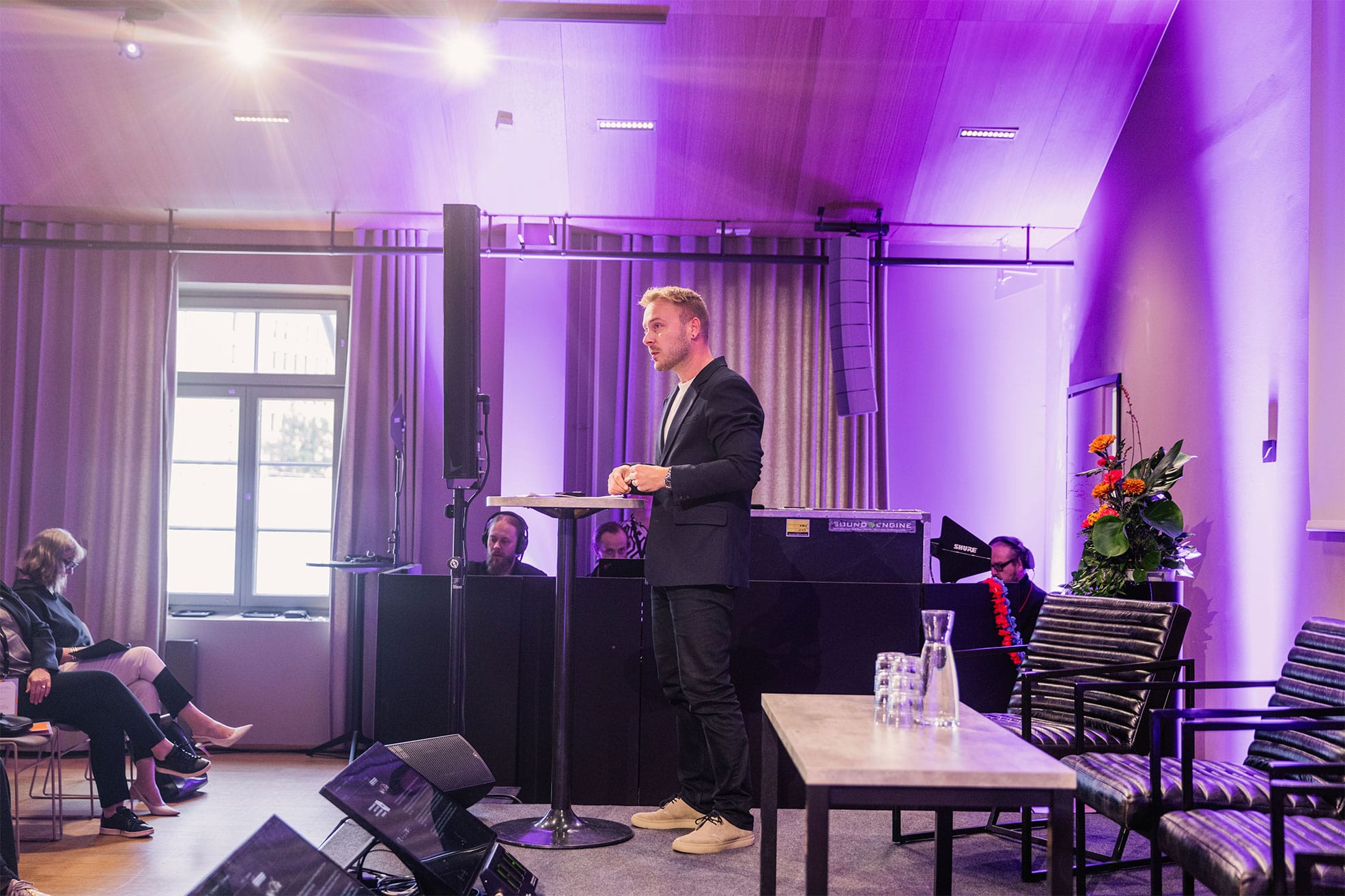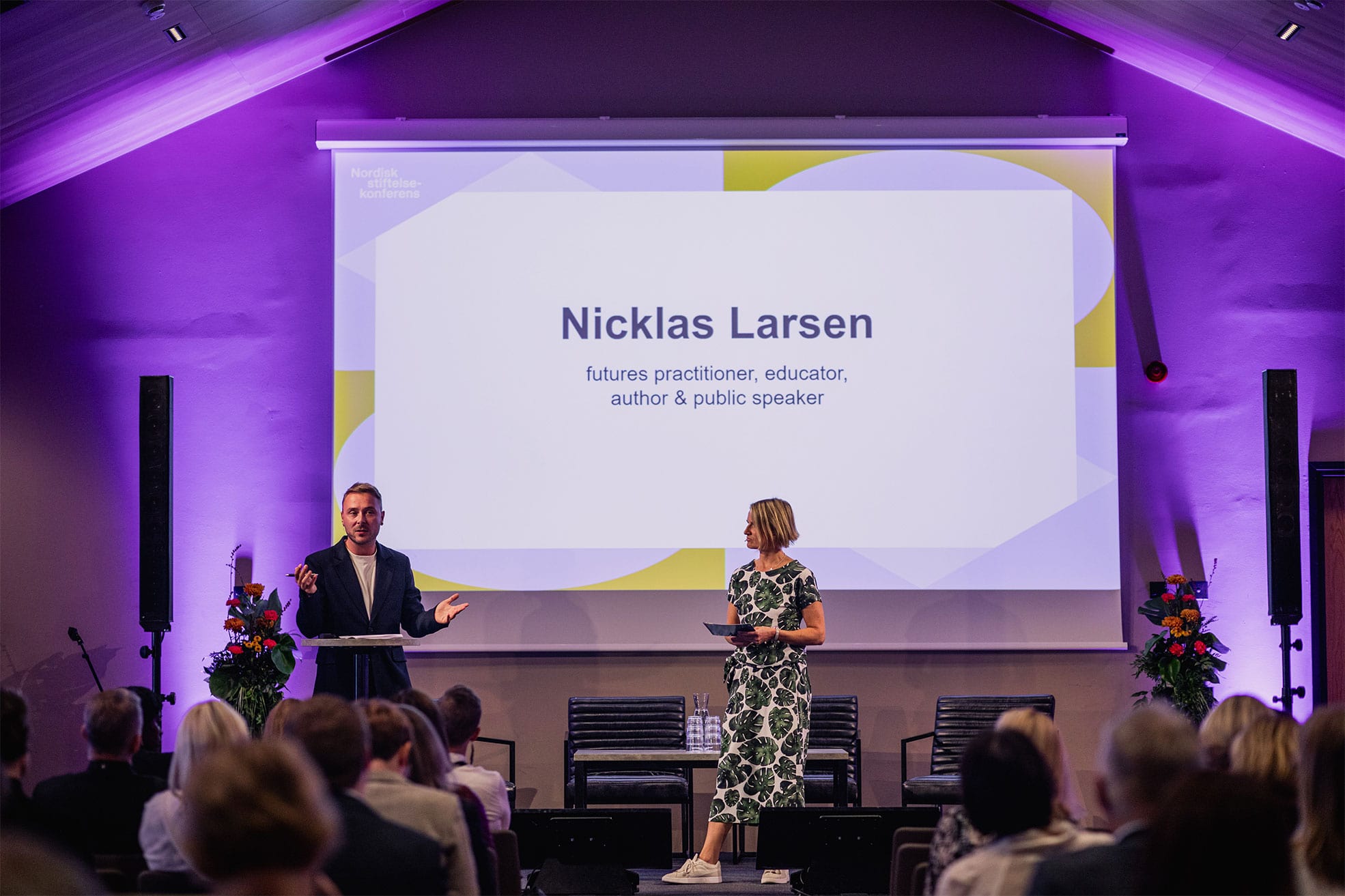The Future is Created Now
The future is shaped by today’s decisions. Foundations have a unique opportunity to look far ahead.

Photo: Frida Lönnroos
What if those who would benefit most from grant decisions haven’t even been born yet?
With this provocative question, futures researcher Nicklas Larsen opened his presentation at the Nordic Foundation Conference in Helsinki on September 25, 2025.
Shortly afterward, Larsen, Director of Impact and Development at the Copenhagen Centre for Futures Studies, emphasized that we cannot predict the future.
“However, that does not prevent us from planning for the future, preparing for it, and mapping its possibilities,” Larsen noted.
Traditionally, the future is defined as a noun—a time that has yet to come. Larsen argues that it can also be understood as a verb, describing the actions and developments that shape tomorrow. In this perspective, the future is something we create every day. Foundations are particularly well-positioned for this long-term work, he believes.
Political systems operate in four-year election cycles. In business, the focus is on succeeding in the present. Foundations, on the other hand, have stability and resources that enable long-term planning and innovation.
Innovation may not be the first thing that comes to mind in the world of foundations, Larsen admits. In his presentation, he highlighted the research project Futures Philanthropy – Anticipation for the Common Good, conducted in collaboration with Philea – Philanthropy Europe Association. The study mapped potential future threats and opportunities for the foundation sector. The greatest threats were seen as conservative governments, slow adaptation, and a tendency to focus solely on mainstream issues. The greatest opportunities were found in systemic thinking and trust-based funding decisions.
When preparing for the future, we should first define common goals and then explore different ways to reach them. This requires collaboration within the foundation community.”
Nicklas Larsen
Scenarios Help Us Prepare
Predicting the future is not easy. Larsen illustrated this with a model dividing problems into four categories. The simplest problems are straightforward, like tic-tac-toe, where the right solution is obvious. The second category involves complicated problems that require more analysis but still have an identifiable best solution—chess, he noted, as an example.
Problems become complex when we lack complete information, as in a card game where we cannot see our opponent’s hand. In such cases, the best solution can often only be determined in hindsight. In chaotic problems, there may not even be a clear solution.
“The problems we face are not just complicated—they cannot be solved with more data or better planning. The future is complex—major changes occur unpredictably and causes and effects often only become clear in retrospect,” Larsen explained.
This becomes particularly evident when considering funding decisions.

“Today’s major challenges—climate change, inequality, migration, youth mental health, and polarization—all exist in a world of complex and chaotic problems. That is why preparing for the future is a core task for foundations: it helps us understand and act proactively.”
The future should therefore be approached through alternative scenarios and the developmental paths that may lead there. This requires an “infrastructure for imagination,” where creativity is given space and resources. It can be stimulated through new social encounters and by engaging diverse actors in joint future-thinking.
“When preparing for the future, we should first define common goals and then explore different ways to reach them. This requires collaboration within the foundation community.”
Shared Goals Are Key
When multiple initiatives move in the same direction, they lay the groundwork for system-level change, Larsen notes. With several approaches, there is no need to put all your eggs in one basket. As an inspiring example, he presented the SOON Laboratory for Possible Futures in Copenhagen, where over a hundred organizations came together during a six-month pilot project to jointly explore future scenarios and preparedness.
“For example, we have discussed the skills and capabilities that will be needed in the future. We aim to lower the barriers to using imagination and to make the conversation about the future more democratic.”
Even the future can be hijacked as a tool by populists. In a healthy society, there is room for multiple, even conflicting, visions of the future”
Nicklas Larsen
The Future Can Be Hijacked
This year’s theme for the Nordic Foundation Conference was polarization. When considering future development paths, Larsen encourages us to reflect on which narratives and perceptions fuel polarization. According to him, the best indicators of polarization are trends in societal trust.
“Do people believe in the possibilities of democracy and in the media? How healthy is civil society—do people feel they can influence society through various organizations and associations?” Larsen asks.
To reduce polarization, there must be spaces where people with different views can meet in a constructive and safe environment. Addressing societal inequality is crucial, as polarization limits opportunities for everyone.
“Even the future can be hijacked as a tool by populists. In a healthy society, there is room for multiple, even conflicting, visions of the future,” Larsen explains.
“If the conversation is limited to a single vision of the future, it easily creates a conflict line: we are either for or against it. This gives rise to a false sense of no alternatives. The future is never simple; it is complex and chaotic and can therefore never be confined to a single scenario.”